EPDM Rubber Moulding: Everything You Need to Know
Welcome to our comprehensive guide to EPDM rubber moulding. In this article, we will provide you with everything you need to know about this versatile and widely used material. Whether you’re a manufacturer, engineer, or simply curious about rubber moulding, this guide will give you valuable insights into EPDM.
EPDM, or Ethylene Propylene Diene Monomer, is a synthetic rubber known for its outstanding resistance to weather, UV radiation, extreme temperatures, and ozone. It is widely used in various industries, including automotive, construction, electrical, and drainage, owing to its excellent durability and flexibility.
Properties and advantages of EPDM rubber
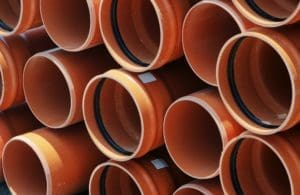 EPDM rubber offers a range of exceptional properties that make it a popular choice in various applications. One of its key advantages is its excellent weather resistance. EPDM can withstand exposure to sunlight, rain, snow, and other harsh weather conditions without deteriorating, making it ideal for outdoor applications.
EPDM rubber offers a range of exceptional properties that make it a popular choice in various applications. One of its key advantages is its excellent weather resistance. EPDM can withstand exposure to sunlight, rain, snow, and other harsh weather conditions without deteriorating, making it ideal for outdoor applications.
Additionally, EPDM rubber exhibits exceptional resistance to UV radiation. Unlike many other materials, EPDM does not degrade or become brittle when exposed to the sun’s rays. This property makes it suitable for long-lasting applications in outdoor environments, such as roofing systems, seals, and gaiters.
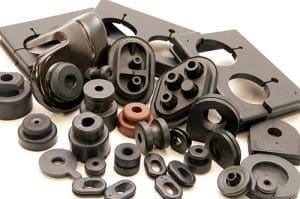 Another standout property of EPDM rubber is its ability to withstand extreme temperatures. It can handle both high and low temperatures without losing its flexibility or becoming damaged. This thermal stability makes EPDM suitable for applications that require resistance to temperature fluctuations, such as automotive hoses, weatherstripping, and electrical insulation.
Another standout property of EPDM rubber is its ability to withstand extreme temperatures. It can handle both high and low temperatures without losing its flexibility or becoming damaged. This thermal stability makes EPDM suitable for applications that require resistance to temperature fluctuations, such as automotive hoses, weatherstripping, and electrical insulation.
EPDM rubber also possesses excellent resistance to ozone, a highly reactive gas present in the earth’s atmosphere. Ozone can cause rubber to crack and degrade over time, but EPDM is highly resistant to this degradation. This property makes it ideal for applications where exposure to ozone is a concern, such as construction vehicles components and seals.
Overall, the outstanding properties of EPDM rubber, including its weather resistance, UV resistance, thermal stability, and ozone resistance, make it a highly desirable material for a wide range of applications.
Types of EPDM rubber moulding processes
EPDM rubber can be moulded using several different processes, each with its own advantages and considerations. The three most common types of EPDM rubber moulding processes are injection moulding, compression moulding, and transfer moulding.
 Injection moulding with EPDM rubber
Injection moulding with EPDM rubber
Injection moulding is a highly versatile and efficient process for manufacturing EPDM rubber parts. It involves injecting molten EPDM rubber into a mould cavity under high pressure. The molten rubber then solidifies, taking the shape of the mould cavity.
One of the key advantages of injection moulding is its ability to produce complex and intricate parts with high precision. The process allows for tight tolerances and consistent part quality, making it suitable for applications that require precise dimensions and intricate designs.
Injection moulding is also a cost-effective process, especially for high volume production. The automated nature of the process allows for fast production cycles and minimal material waste. Additionally, EPDM rubber is well-suited for injection moulding due to its excellent flow properties and quick solidification.
Compression moulding with EPDM rubber
 Compression moulding is another popular process for EPDM rubber moulding. It involves placing a pre-determined amount of EPDM rubber compound into a mould cavity and compressing it under high pressure and heat. The heat causes the rubber to flow and conform to the shape of the mould.
Compression moulding is another popular process for EPDM rubber moulding. It involves placing a pre-determined amount of EPDM rubber compound into a mould cavity and compressing it under high pressure and heat. The heat causes the rubber to flow and conform to the shape of the mould.
Compression moulding is suitable for manufacturing medium to large-sized EPDM rubber parts. It allows for good dimensional control and can produce parts with varying thicknesses. The process also provides excellent surface finish and can accommodate inserts or other additional features.
One of the advantages of compression moulding is its suitability for low volume production or prototyping. It does not require complex moulds or expensive machinery, making it a cost-effective option for small-scale production. However, the process can be slower compared to injection moulding, and the cycle time can vary depending on the part size and complexity.
Transfer moulding with EPDM rubber
Transfer moulding is a hybrid process that combines elements of both injection moulding and compression moulding. It involves placing a pre-determined amount of EPDM rubber compound into a pot or transfer chamber, which is then forced into a mould cavity under high pressure and heat.
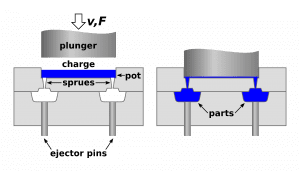 Transfer moulding offers the advantages of both injection moulding and compression moulding. It allows for the production of complex parts with high precision, similar to injection moulding. At the same time, it provides the flexibility and cost-effectiveness of compression moulding, making it suitable for both low and medium volume production.
Transfer moulding offers the advantages of both injection moulding and compression moulding. It allows for the production of complex parts with high precision, similar to injection moulding. At the same time, it provides the flexibility and cost-effectiveness of compression moulding, making it suitable for both low and medium volume production.
One of the key advantages of transfer moulding is its ability to accommodate inserts or other pre-formed components. This makes it ideal for manufacturing EPDM rubber parts with metal or plastic inserts, such as electrical connectors or automotive components.
Overall, the choice of moulding process for EPDM rubber depends on various factors, including the part design, volume requirements, cost considerations, and the desired properties of the final product. Manufacturers can work closely with rubber moulding experts to determine the most suitable process for their specific needs.
Common applications of EPDM rubber moulding

EPDM rubber moulding finds widespread use in a range of industries and applications, thanks to its exceptional properties and versatility. Some of the common applications of EPDM rubber moulding include:
Automotive industry
EPDM rubber is widely used in the automotive industry for various applications. It is commonly found in seals, gaiters, hoses, and vibration dampening components. EPDM’s resistance to weather, UV radiation, and extreme temperatures make it an ideal material for automotive parts that are exposed to harsh environmental conditions.
 Construction industry
Construction industry
In the construction industry, EPDM rubber is used for roofing systems, window seals, door gaskets, and expansion joints. EPDM’s excellent weather resistance and durability make it suitable for long-lasting applications in buildings and infrastructure. It is also commonly used as a sealant for windows and doors, providing a watertight and airtight barrier.
Electrical industry
EPDM rubber is widely used in the electrical industry for insulation purposes. It is an excellent electrical insulator and can withstand high voltages, making it suitable for cables, wires, and electrical connectors. EPDM’s resistance to ozone and extreme temperatures further enhances its suitability for electrical applications.
Aerospace industry
EPDM rubber is used in the aerospace industry for various applications, including seals, gaskets, and vibration dampening components. The material’s ability to withstand extreme temperatures, UV radiation, and ozone makes it well-suited for aerospace applications where reliability and durability are paramount.
Other industries
EPDM rubber is also used in other industries, such as marine, medical, and consumer goods. It finds applications in boat seals, medical tubing, O-rings, and various household products. The versatility of EPDM rubber allows it to be tailored to specific requirements, making it suitable for a wide range of applications beyond the industries mentioned above.

Benefits of using EPDM rubber moulding
There are several key benefits to using EPDM rubber moulding for your projects. Here are some of the main advantages:
Durability and longevity
EPDM rubber is known for its exceptional durability and longevity. It can withstand exposure to harsh weather conditions, UV radiation, extreme temperatures, and ozone without deteriorating or losing its properties. This makes EPDM rubber moulded parts highly reliable and long-lasting, reducing the need for frequent replacements.
Flexibility and elasticity
EPDM rubber is highly flexible and exhibits excellent elastic properties. It can stretch and compress without permanent deformation, making it suitable for applications that require resilience and the ability to absorb shocks or vibrations. EPDM rubber moulded parts can maintain their shape and performance even under repeated stress or movement.
Chemical resistance
EPDM rubber has good resistance to a wide range of chemicals, including acids, alkalis, and various solvents. This chemical resistance makes EPDM suitable for applications that involve exposure to different substances or environments. It can provide a reliable barrier against chemical corrosion or degradation.
Ease of moulding and customisation
EPDM rubber is relatively easy to mould and process, allowing for efficient manufacturing of complex parts. It can be tailored to specific requirements by adjusting the formulation or adding fillers and reinforcements. This flexibility in customisation makes EPDM rubber moulding suitable for a wide range of applications with varying performance needs.
Cost-effectiveness
EPDM rubber moulding offers cost advantages, especially for high volume production. The efficient manufacturing processes, such as injection moulding, allow for fast production cycles and minimal material waste. EPDM’s durability and longevity also contribute to cost savings by reducing maintenance and replacement costs over time.
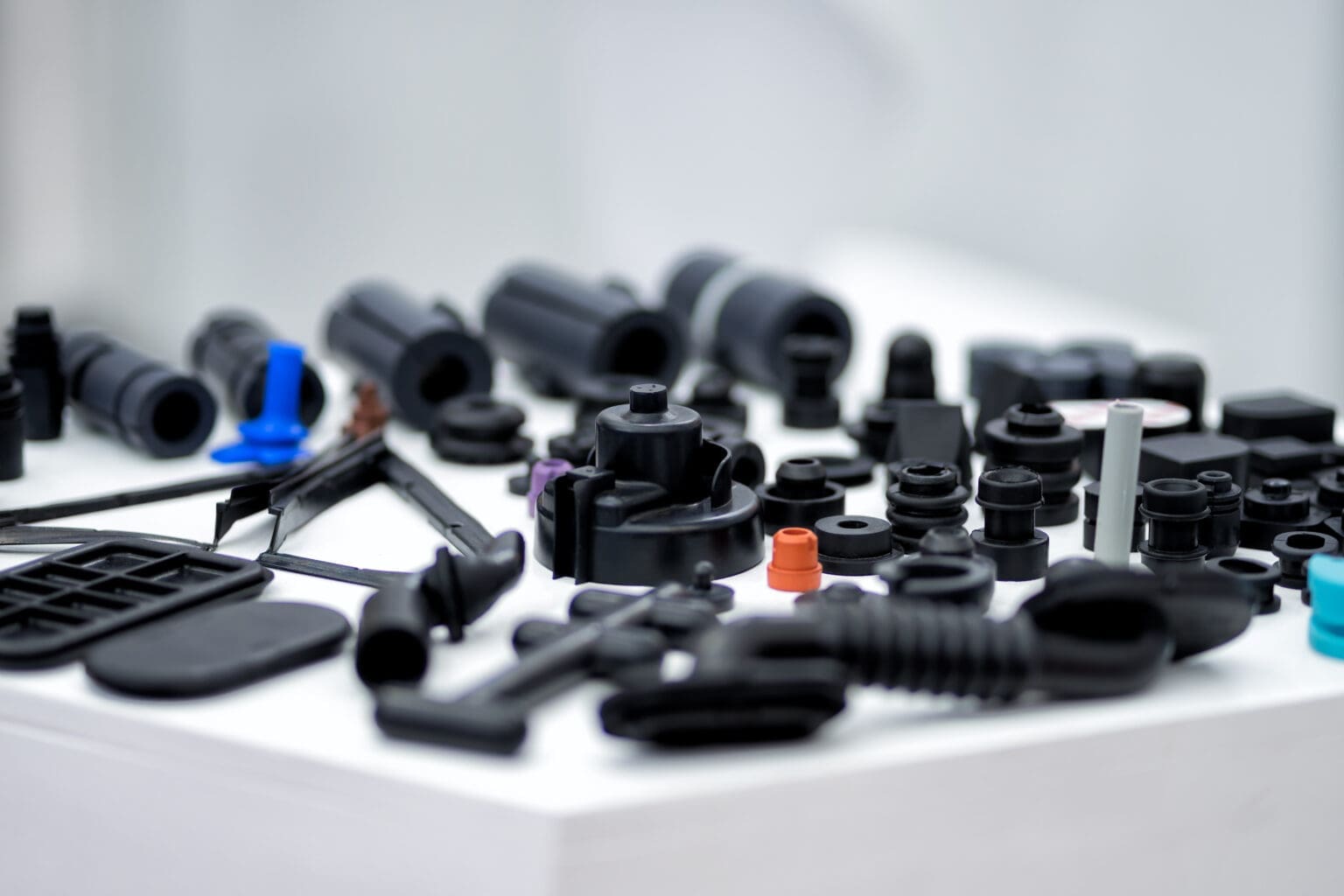
Choosing the right EPDM rubber moulding manufacturer
When selecting an EPDM rubber moulding manufacturer, several factors should be considered to ensure the best results for your projects. Here are some tips to guide your decision-making process:
Expertise and experience
Look for a manufacturer with expertise and experience in EPDM rubber moulding. A knowledgeable manufacturer will understand the properties and characteristics of EPDM rubber and can provide valuable insights during the design and manufacturing process. They should have a track record of successful projects and a reputation for quality.
Customisation capabilities
Consider the manufacturer’s ability to customise EPDM rubber moulded parts to your specific requirements. EPDM rubber can be tailored to different specifications by adjusting the formulation or incorporating additives. The manufacturer should have the necessary expertise and facilities to accommodate these customisation needs.
Quality control and certifications
Ensure that the manufacturer has robust quality control processes in place. Ask about their quality certifications, such as ISO 9001, which demonstrate their commitment to delivering high-quality products. Quality control measures should cover all stages of the manufacturing process, from material selection to final inspection.
Production capacity and scalability
Evaluate the manufacturer’s production capacity and scalability to meet your volume requirements. Consider whether they have the necessary infrastructure, machinery, and resources to handle your project’s demands. A manufacturer with the ability to scale production can accommodate your future needs as your business grows.
Communication and collaboration
Effective communication and collaboration are crucial when working with an EPDM rubber moulding manufacturer. Choose a manufacturer who is responsive, open to feedback, and willing to collaborate closely on your project. Clear communication channels will ensure that your expectations are met and that any issues or concerns are addressed promptly.

Conclusion
EPDM rubber moulding offers a range of benefits and applications across various industries. Its exceptional resistance to weather, UV radiation, extreme temperatures, and ozone make it a versatile and durable material. With different moulding processes available, such as injection moulding, compression moulding, and transfer moulding, EPDM rubber can be used to manufacture complex and precise parts.
When choosing an EPDM rubber moulding manufacturer, consider their expertise, customisation capabilities, quality control measures, production capacity, and communication skills. By selecting the right manufacturer, you can ensure the successful realisation of your projects and enjoy the many advantages that EPDM rubber moulding has to offer.
So, whether you’re looking to enhance the durability of automotive components, improve the performance of electrical connectors, or explore new applications for EPDM rubber moulding, understanding the properties, processes, and applications of EPDM rubber will help you make informed decisions and achieve your desired outcomes.
Remember, EPDM rubber moulding is a versatile and reliable solution that can withstand the toughest conditions, making it an excellent choice for a wide range of projects.
For more about EPDM rubber moulding or to discuss your requirements, get in touch with one of our experts today.

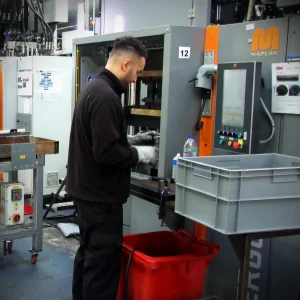 Injection moulding with EPDM rubber
Injection moulding with EPDM rubber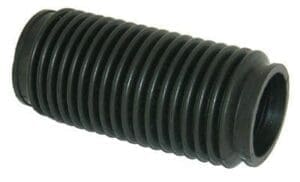 Construction industry
Construction industry